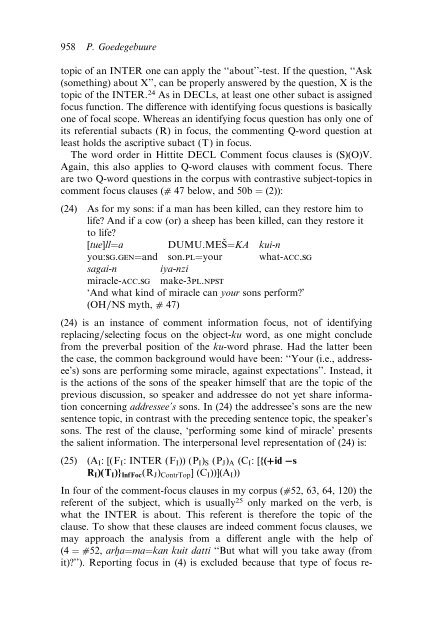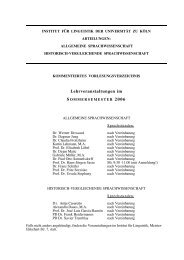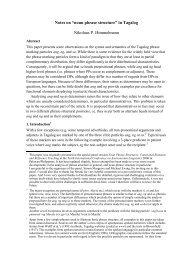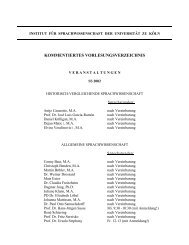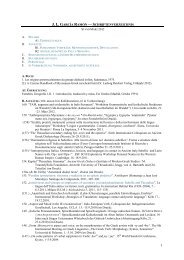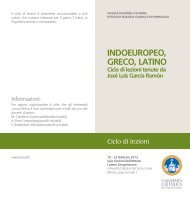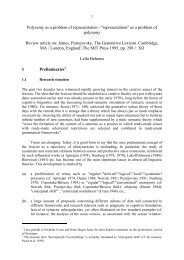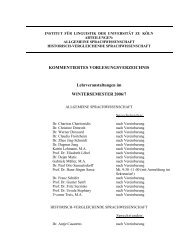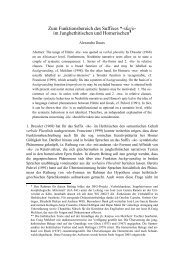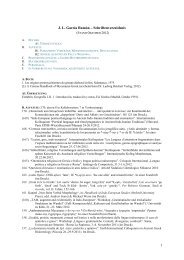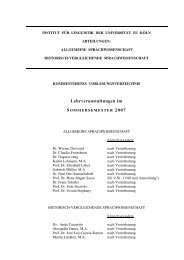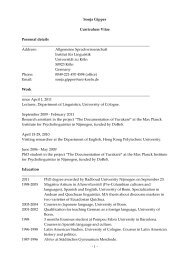Topics in Anatolian Historical Grammar Prof. Dr. H. Craig Melchert
Topics in Anatolian Historical Grammar Prof. Dr. H. Craig Melchert
Topics in Anatolian Historical Grammar Prof. Dr. H. Craig Melchert
You also want an ePaper? Increase the reach of your titles
YUMPU automatically turns print PDFs into web optimized ePapers that Google loves.
958 P. Goedegebuure<br />
topic of an INTER one can apply the ‘‘about’’-test. If the question, ‘‘Ask<br />
(someth<strong>in</strong>g) about X’’, can be properly answered by the question, X is the<br />
topic of the INTER. 24 As <strong>in</strong> DECLs, at least one other subact is assigned<br />
focus function. The di¤erence with identify<strong>in</strong>g focus questions is basically<br />
one of focal scope. Whereas an identify<strong>in</strong>g focus question has only one of<br />
its referential subacts (R) <strong>in</strong> focus, the comment<strong>in</strong>g Q-word question at<br />
least holds the ascriptive subact (T) <strong>in</strong> focus.<br />
The word order <strong>in</strong> Hittite DECL Comment focus clauses is (S)(O)V.<br />
Aga<strong>in</strong>, this also applies to Q-word clauses with comment focus. There<br />
are two Q-word questions <strong>in</strong> the corpus with contrastive subject-topics <strong>in</strong><br />
comment focus clauses (a 47 below, and 50b ¼ (2)):<br />
(24) As for my sons: if a man has been killed, can they restore him to<br />
life? And if a cow (or) a sheep has been killed, can they restore it<br />
to life?<br />
[tue]ll¼a DUMU.MEŠ¼KA kui-n<br />
you:sg.gen¼and son.pl¼your what-acc.sg<br />
sagai-n iya-nzi<br />
miracle-acc.sg make-3pl.npst<br />
‘And what k<strong>in</strong>d of miracle can your sons perform?’<br />
(OH/NS myth, a 47)<br />
(24) is an <strong>in</strong>stance of comment <strong>in</strong>formation focus, not of identify<strong>in</strong>g<br />
replac<strong>in</strong>g/select<strong>in</strong>g focus on the object-ku word, as one might conclude<br />
from the preverbal position of the ku-word phrase. Had the latter been<br />
the case, the common background would have been: ‘‘Your (i.e., addressee’s)<br />
sons are perform<strong>in</strong>g some miracle, aga<strong>in</strong>st expectations’’. Instead, it<br />
is the actions of the sons of the speaker himself that are the topic of the<br />
previous discussion, so speaker and addressee do not yet share <strong>in</strong>formation<br />
concern<strong>in</strong>g addressee’s sons. In (24) the addressee’s sons are the new<br />
sentence topic, <strong>in</strong> contrast with the preced<strong>in</strong>g sentence topic, the speaker’s<br />
sons. The rest of the clause, ‘perform<strong>in</strong>g some k<strong>in</strong>d of miracle’ presents<br />
the salient <strong>in</strong>formation. The <strong>in</strong>terpersonal level representation of (24) is:<br />
(25) (A I :[(F I : INTER (F I )) (P I ) S (P J ) A (C I :[{(Bid Cs<br />
R I )(T I )} InfFoc (R J ) ContrTop ](C I ))](A I ))<br />
In four of the comment-focus clauses <strong>in</strong> my corpus (a52, 63, 64, 120) the<br />
referent of the subject, which is usually 25 only marked on the verb, is<br />
what the INTER is about. This referent is therefore the topic of the<br />
clause. To show that these clauses are <strong>in</strong>deed comment focus clauses, we<br />
may approach the analysis from a di¤erent angle with the help of<br />
(4 ¼ a52, a¼ma¼kan kuit datti ‘‘But what will you take away (from<br />
it)?’’). Report<strong>in</strong>g<br />
arh˘<br />
focus <strong>in</strong> (4) is excluded because that type of focus re-


